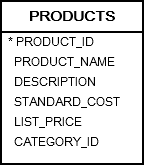Summary: in this tutorial, you will learn how to use the Oracle AVG() function to calculate the average of a group.
Introduction to Oracle AVG() function syntax #
The Oracle AVG()
Here’s the syntax of the Oracle AVG()
AVG([DISTINCT | ALL ] expression)Code language: SQL (Structured Query Language) (sql)The AVG()DISTINCT or ALL.
The DISTINCT clause instructs the function to ignore the duplicate values while the ALL clause causes the function to consider all the duplicate values.
For example, the average DISTINCT of 1, 1, 2, and 3 is (1 + 2 + 3 ) / 3 = 2, while the average ALL of 1, 1, 2, and 3 is (1 + 1 + 2 + 3) /4 = 1.75
The AVG()
Oracle AVG() function examples #
We will use the products table in the sample database for the demonstration.

Basic Oracle AVG() function example #
The following example uses the AVG function to calculate the average standard costs of all products:
SELECT
ROUND(AVG(standard_cost), 2) avg_std_cost
FROM
products;Code language: SQL (Structured Query Language) (sql)
Notice that we used the ROUND()
You can also use multiple AVG()
SELECT
ROUND(AVG(standard_cost), 2) avg_std_cost,
ROUND(AVG(list_price), 2) avg_list_price
FROM
products;Code language: SQL (Structured Query Language) (sql)
Oracle AVG() function with DISTINCT clause #
The following statement calculates the average DISTINCT list prices:
SELECT
ROUND(AVG(DISTINCT list_price), 2) avg_list_price
FROM
products;Code language: SQL (Structured Query Language) (sql)
The result of the average DISTINCT is different from the average ALL above because some products have the same list prices.
Oracle AVG() function with GROUP BY clause #
The following example calculates the average list price of products by category:
SELECT
category_id,
ROUND(
AVG( list_price ),
2
) avg_list_price
FROM
products
GROUP BY
category_id;
Code language: SQL (Structured Query Language) (sql)
In this example, the GROUP BY clause divides the products by category and then the AVG()
To make the result more readable, you can also retrieve the category name by adding an INNER JOIN clause to the query above:
SELECT
category_name,
ROUND(AVG(list_price), 2) avg_list_price
FROM
products
INNER JOIN product_categories USING (category_id)
GROUP BY
category_name
ORDER BY
category_name;Code language: SQL (Structured Query Language) (sql)
Oracle AVG() function with HAVING clause #
The following example returns the product categories whose average list prices are greater than 1000 specified by the HAVING clause:
SELECT
category_name,
ROUND(AVG(list_price), 2) avg_list_price
FROM
products
INNER JOIN product_categories USING (category_id)
GROUP BY
category_name
HAVING
AVG(list_price) > 1000
ORDER BY
category_name;Code language: SQL (Structured Query Language) (sql)Output:
 #
#
The following HAVING clause is used to filter groups of product categories.
HAVING
AVG( list_price )> 1000
Code language: SQL (Structured Query Language) (sql)Using Oracle AVG() function in subqueries #
Consider the following example:
SELECT
ROUND(AVG(avg_list_price), 2) avg_of_avg
FROM
(
SELECT
AVG(list_price) avg_list_price
FROM
products
GROUP BY
category_id
);Code language: SQL (Structured Query Language) (sql)
In this example:
- The subquery returns the average list prices by product category.
- The outer query returns the average of the average list prices per product category.
Using Oracle AVG() function with NULL values #
Let’s create a new table called performances for the demonstration.
CREATE TABLE performances (
employee_id NUMBER PRIMARY KEY,
score NUMBER (3, 1)
);
INSERT INTO
performances (employee_id, score)
VALUES
(1, 95);
INSERT INTO
performances (employee_id, score)
VALUES
(2, 70);
INSERT INTO
performances (employee_id, score)
VALUES
(3, 60);
INSERT INTO
performances (employee_id, score)
VALUES
(4, NULL);
SELECT
*
FROM
performances;Code language: SQL (Structured Query Language) (sql)
The following statement uses the AVG function to calculate the average score of all employees:
SELECT
AVG(score)
FROM
performances;Code language: SQL (Structured Query Language) (sql)Output:

The output indicates that the the AVG() function ignores NULL.
Using Oracle AVG() with NVL() function #
If you want to treat the NULL value as zero for calculating the average, you can use AVG()NVL()
SELECT
AVG(NVL (score, 0))
FROM
performances;Code language: SQL (Structured Query Language) (sql)The NVL() function returns 0 if the score is NULL.
Output:

Summary #
- Use the Oracle
AVG()function to calculate the average of a group of values. - Use the
DISTINCTto calculate the average of distinct values in a set. - Use the
ALLoption to calculate the average of all values.
